Compare prices between different insurer providers and use the promo code 'PAULTAN10' when you make your payment to save the most on your car insurance renewal compared to other competing services.


Latest Featured Stories
2024 GWM Ora 07 Review - Better than the BYD & Tesla?
Latest Certified Pre-Owned with 1 Year Warranty
10% discount when you renew your car insurance with us
Compare prices between different insurer providers and use the promo code 'PAULTAN10' when you make your payment to save the most on your car insurance renewal compared to other competing services.


Search oto.my Car Classifieds
Latest Stories
In Cars, International News, Perodua / By Anthony Lim / / 0 comment
Perodua has added another foreign market to its export portfolio, with the brand now having made its way to Bangladesh. Last month, the national automaker inked a deal with PHP Motors, a subsidiary of the PHP Family, for the latter to assemble and sell its vehicle models in the country.
According to The Business Standard, PHP Motors is launching four Perodua models in Dhaka today. The four models are the Axia, Myvi, Bezza and Aruz, and will be assembled at the company’s Saraipara Halishahar plant in Chattogram (formerly Chittagong). PHP Motors MD Mohammed Akther Parvez added that there were plans to expand the line-up in the coming future.
“Perodua has six models. We are working on all the models. Initially, we will assemble (these) four models in our factory and sell them. The other models (the Alza and Ativa) will also be assembled and launched soon,” he said.
If the PHP name sounds familiar, that’s because the company used to handle Proton. Proton is now represented in Bangladesh by local conglomerate Rancon, which is set to assemble the X90 in the country later this year.
Although PHP has terminated its agreement with Proton, it said it would honour all existing warranties for Proton vehicles. “While signing the agreement with Perodua, we have included this condition to allow us to provide after-sales services to previously sold Proton cars and they have appreciated our commitment,” Akther said.
PHP’s factory is capable of assembling 1,200 units a year. With over 400 employees, the plant can assemble 36 cars in three shifts a day (12 in each shift). The company said that the facility has been running at full capacity since 2019.
In Local News / By Paul Tan / / 0 comment
Following today’s monetary policy committee (MPC) meeting, Bank Negara Malaysia (BNM) has decided to maintain the overnight policy rate (OPR) at 3%. The 3% OPR has been the same since May 2023 when it was increased by 25 basis points from 2.75%.
Car loans are affected by the OPR, because if banks have higher borrowing costs, it will pass them on to the consumer with with higher rates resulting in hire purchase loans becoming more expensive and potentially harder to gain approval. Thus, any hike in OPR have an impact on car sales. So with no rate hike, this should be good news for the MAA.
According to BNM, the OPR level is in line with the health of the economy and remains supportive of growth while keeping inflation in check. The BNM MPC meets to make OPR decisions every two months.
The next meeting will be in July 2024.
Here is BNM’s full statement:
Monetary Policy Statement May 2024
At its meeting today, the Monetary Policy Committee (MPC) of Bank Negara Malaysia decided to maintain the Overnight Policy Rate (OPR) at 3.00 percent.
The global economy continues to expand amid resilient labour markets in some countries and continued recovery in global trade. Looking ahead, global growth is expected to be sustained, as headwinds from tight monetary policy and reduced fiscal support will be cushioned by positive labour market conditions and moderating inflation. Global trade is expected to strengthen further as the global tech upcycle gains momentum. While global headline and core inflation continued to edge downwards in recent months, the pace for disinflation has slowed in some advanced economies. This increases the prospect of interest rates to remain high for longer, particularly in the US. The growth outlook remains subject to downside risks, mainly from further escalation of geopolitical tensions, higher-than-anticipated inflation outturns, and volatility in global financial markets.
For the Malaysian economy, the latest indicators point towards higher economic activity in the first quarter of 2024, driven by resilient domestic expenditure and a positive turnaround in exports. Going forward, the recovery in exports is expected to gather momentum supported by the global tech upcycle and continued strength in non-electrical and electronics goods. Tourist arrivals and spending are also poised to rise further. Continued employment and wage growth remain supportive of household spending. Investment activity would be supported by the ongoing progress of multi-year projects in both the private and public sectors, the implementation of catalytic initiatives under the national master plans, as well as the higher realisation of approved investments. The growth outlook is subject to downside risks from weaker-than-expected external demand, and larger declines in commodity production. Meanwhile, upside risks to growth mainly emanate from greater spillover from the tech upcycle, more robust tourism activity, and faster implementation of existing and new projects.
Headline and core inflation averaged 1.7% and 1.8% in the first quarter of 2024 respectively. Looking forward, inflation in 2024 is expected to remain moderate, broadly reflecting stable demand conditions and contained cost pressures. The outlook for the rest of the year is dependent on the implementation of domestic policy on subsidies and price controls, as well as global commodity prices and financial market developments. After incorporating the potential impact of subsidy rationalisation, headline and core inflation are projected to average between 2.0% – 3.5% and 2.0% – 3.0% for the year respectively.
The ringgit currently does not reflect Malaysia’s economic fundamentals and growth prospects. External factors, namely shifting expectations of major economies’ monetary policy paths and ongoing geopolitical tensions, have led to heightened volatility in both capital flows and exchange rates across the region, including the ringgit. The coordinated initiatives by the Government and Bank Negara Malaysia (BNM) with the Government-Linked Companies (GLCs) and Government-Linked Investment Companies (GLICs), and corporate engagements have gained further traction, cushioning the pressure on the ringgit. BNM will continue to manage risks arising from heightened financial market volatility. Over the medium term, domestic structural reforms will provide more enduring support to the ringgit.
At the current OPR level, the monetary policy stance remains supportive of the economy and is consistent with the current assessment of the inflation and growth prospects. The MPC remains vigilant to ongoing developments to inform the assessment on the outlook of domestic inflation and growth. The MPC will ensure that the monetary policy stance remains conducive to sustainable economic growth amid price stability.
In Local News, Public Transport / By Anthony Lim / / 0 comment
Having stated its intention to develop a multi-tiered automated rapid transit (ART) system in Johor Bahru in order to address traffic congestion in the city, the Johor state government is now preparing to submit a proposal to the federal government for the project to be green-lighted, the Malay Mail reports.
According to state executive councillor Lee Ting Han, the state will evaluate the proposal before sending it to the transport and economy ministries. “The state government will be submitting a proposal to the federal government about the establishment of an elevated ART. It will be discussed and approved at the state level during the weekly Johor executive council meeting before it is submitted,” he said.
Lee said that the state is anticipating increased traffic once the Rapid Transit System Link (RTS Link) starts operating in about three years. “The RTS Link is able to transport 10,000 passengers per hour per direction, so we are forecasting a high volume of people traveling between Johor and Singapore daily. If each of them takes their own private vehicle, it will be severely congested in the Johor Baru city centre. We must find a way to disperse the crowd and the elevated ART is a good mode to do so,” he said.
Lee said the ART system has been successfully implemented in numerous countries and highlighted its upcoming implementation in Kuching. He said that a team from Johor visited Sarawak to study the feasibility and proposal procedures for the project, and the insights gleaned from the visit will be incorporated into the state government’s submission to the federal government.
As for the proposed routes for the elevated ART system, Lee said that the state intends to utilise the existing alignment of the Iskandar Malaysia Bus Rapid Transit (IMBRT) project, which was announced in 2018 and uses dedicated busways to serve key areas. The choice of utilising the IMBRT alignment would save costs, as it would utilise partially acquired land along the routes.
“So, we are proposing an elevated ART that follows the IMBRT alignment as the land acquisition along the routes has been done partially. Once we receive the federal approvals, we can start work as soon as possible because the clock is ticking. If we do not plan it (properly), we will be choking up the city centre,” he said.
The ART is classed as a medium-capacity transit system for urban passenger transport, which allows for higher passenger capacity at a lower cost of implementation compare to light-rail systems, and will run on clean sources of energy such as electricity or hydrogen.
In Advertorial, Videos / By Harvinder Sidhu /
In this insightful episode of the “Ikigai” series, we look at the everyday life of a car painter in Malaysia who shares his philosophy on the importance and satisfaction derived from his work.
Despite the common perception that painting cars is a mundane and simplistic job, this episode uncovers what makes Jumpei Yamamoto enjoy his work so much that he has stuck to it over the last 25 years.
Yama-san as he is fondly called has accumulated a wealth of experience at companies like Mitsubishi Motors, Rock Paint Co. Ltd. and even as a Japanese civil servant teaching painting techniques for the Advanced Technical College Painting Course. Yes, under the jurisdiction of the Ministry of Health, Labor and Welfare, he has served as a chief examiner for national qualifications in Japan.
The episode begins by addressing the common misconception surrounding the car painter’s job. Often viewed merely as mixing and applying colors, the painter explains how this perception overlooks the artistic and impactful nature of his work. The detailed explanation sheds light on how each stroke and choice of color plays a crucial role in the car’s overall appeal and the owner’s satisfaction.
Watch the episode to learn more about car spray painting and if you would like to get your car repainted by Yama-san’s team you can learn more about Carro Care’s spray paint service by clicking here.
In Cars, Local News, Volkswagen / By Anthony Lim / / 7 comments
While Volkswagen is a major player in the global automotive arena, the brand has a more measured presence in Malaysia, but things may be set to change in the coming future with regards to volume, if what minister of international trade and industry Tengku Datuk Seri Zafrul Abdul Aziz says rings true.
According to the MITI minister, the German automaker has plans to make Malaysia an export centre for the brand. In a post on X, he said that this was revealed by the company during his recent meeting with Volkswagen Group Malaysia (VGM) executives, said in response to a question he posed as to whether the company had plans to make the country an export hub.
In his post, he said that in addition to conventional models, the company also plans to produce EV vehicles in Malaysia, although no details were revealed as to which models are in that pipeline or when production would begin.
Local assembly is a common thread in the brand’s present line-up in the country, with the Arteon R-Line, Golf GTI, Tiguan Allspace variants and the new Touareg R-Line all built by VGM at the Hicom plant in Pekan, Pahang. For the latter, it’s the first time it’s being assembled outside of Europe.
In BAIC, Cars, Great Wall Motor, Local News / By Anthony Lim / / 5 comments
EP Manufacturing (EPMB) is targeting to begin vehicle production at its factory in Hicom Pegoh Industrial Park in Melaka in the third quarter of this year. According to EPMB CEO Ahmad Razlan Mohamed, the company is looking to produce 6,000 units by year-end, the Malaysian Reserve reports.
Production, which will be carried out by the company’s subsidiary, Peps-JV Melaka (PJVM), will kick off with builds for two Chinese carmakers. The first is China-based Beijing Automotive Group (BAIC), with the company having inked an 10-year vehicle assembly agreement with the carmaker in April. Initial models slated for production being the BJ40 Plus and X55II SUVs, with the CKD forms expected to debut in 2025.
EPMB will serve as a vehicle assembler, with BAIC providing relevant technical support and training as well as guidance and supervision on the assembly and manufacturing process. The Chinese automaker will be responsible for the sales and marketing of vehicles in the region.
The company will also produce vehicles for Great Wall Motor (GWM), with EPMB, via PJVM, having been appointed earlier this year as a contract vehicle assembler for the Chinese automaker in Malaysia for a period of eight years. EPMB will initially assemble the Haval H6 Hybrid and the Haval Jolion in Malaysia for GWM.
In October last year, EPMB announced that over RM100 million would be invested for the construction of the plant in Melaka. The facility is expected to create around 1,000 new jobs upon full operation and produce up to 30,000 vehicles annually in the first phase of its operations. The company has said it is aiming for an annual output of 20,000 units by 2028.
GALLERY: GWM Haval H6 Hybrid RHD Malaysian-specification previewed in China
GALLERY: BAIC X55 II at Auto China 2024
GALLERY: BAIC BJ40 at Auto China 2024
In Cars, Isuzu, Local News / By Gerard Lye / / 7 comments
The new Isuzu D-Max facelift will be launched in Malaysia on May 14, 2024 at 7pm. This is according to a dedicated page on Isuzu Malaysia’s website where the public can register their interest for the updated pick-up truck, which made its initial debut in Thailand last October.
Styling changes for the D-Max, which is currently in its third generation, include a reprofiled front grille that still retains the “fang-like” insert. There’s also a new front bumper with sharper cutouts for the fog lamp cutouts, while the headlamps have been reshaped and feature a different daytime running light signature that wraps along the top portion of each cluster.
At the rear, the taillights get a more distinctive triple-tier look and the tailgate has been tweaked so there are creases at the top and bottom rather than on the sides, as on the pre-facelift model. While the exterior changes are noticeable, the interior remains largely unchanged with a pretty identical dashboard layout.
In Thailand, higher trims get a larger seven-inch multi-info display and paddle shifters, along with an ADAS suite that includes autonomous emergency braking, adaptive cruise control, lane departure warning and automatic high beam.
Based on the ROI page on Isuzu Malaysia’s website, the refreshed D-Max will be offered in a variety of variants and powertrain configurations. The latter should include returning turbodiesel engines like the 4JJ3-TCX 3.0 litre inline-four with 190 PS and 450 Nm of torque along with the RZ4E-TC 1.9 litre inline-four making 150 PS and 350 Nm. Transmission options include a six-speed manual and automatic, with four-wheel drive being standard on most variants. Here’s what’s listed on the page:
the latter including what should be the fami which we have listed below:
Single Cab
Standard
Auto Plus
Premium
X-Terrain
Other details like pricing and spec sheets are not found on the page, but we won’t need to wait long to for those because the launch is less than a week away.
GALLERY: Third-generation Isuzu D-Max facelift at the 2024 Bangkok International Motor Show
GALLERY: Third-generation Isuzu D-Max facelift
In Bikes, Electric motorcycles, Local Bike News, Ni Hsin EV Tech / By Mohan K Ramanujam / / 7 comments
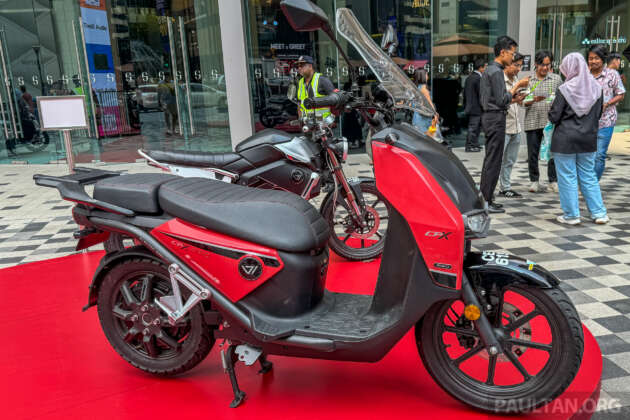
Entering the Malaysian electric mobility market are the Ni Hsin EV Tech TC Max electric motorcycle and CPx Pro electric scooter. The TC Max is priced in Malaysia at RM19,900 while the CPx Pro retails at RM25,900.
Manufactured by Nanjing VMoto Manufacturing Co in China, the VMoto electric motorcycle and scooter are assembled in Malaysia by NH EV Tech in Malaysia under licence. A comprehensive sales and marketing network of distributors and dealers around the Peninsular and East Malaysia has been established to serve owners of the TC Max and CPx Pro.
The TC Max comes with the electric equivalent of 6.7 hp, or about the same performance level as a 125 cc motorcycle, with a maximum torque of 160 Nm measured at the motor. The 5 kW electric motor is mid-mounted, and drives the rear wheel via belt.
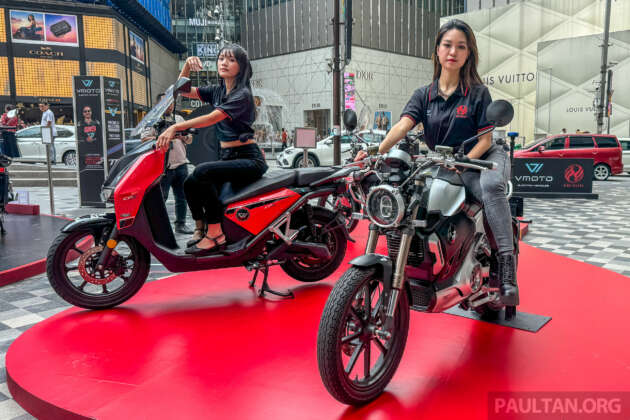
The large removable lithium polymer battery is rated at 60v 45Ah with a weight of 22 kg. According to the specifications sheet, the TC Max takes between three to four hours to charge with domestic current, giving a range of 95 km and a governed top speed of 95 km/h.
Weight of the TC Max is listed at 79 kg sans battery, with a total weight of 101 kg when charged and ready to go while seat height is set at 770 mm. A combined braking system acts of the front and hydraulic disc brakes, with suspension using upside-down front forks and a preload adjustable monoshock.
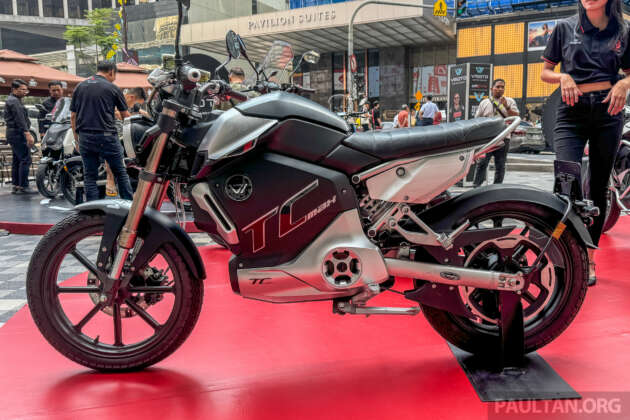
Meanwhile, the CPx Pro gets 220 km range from its dual battery packs located under the seat. The batteries power an electric motor producing the equivalent of 10.72 hp, with 258 Nm of torque while maximum speed is limited to 105 km/h.
Speed is limited to 90 km/h, with the CPx Pro tipping the scales at 125 kg including battery. NH EV Tech offers retail sales, rent-to-own and rental schemes covering B2B, B2G and B2C market segments, along with the ability to customise the TC Max and CPx Pro with accessories such as panniers, sirens and radio systems, for police, army and security enforcement unit duties.
In Local News, Public Transport / By Anthony Lim / / 1 comment
Rapid Rail has announced that all services on the KL Monorail have resumed as of 5pm this evening (Wednesday, May 8), with trains running at up to seven minutes interval during peak hours. The rail service had been disrupted since yesterday evening due to a fallen tree on Jalan Sultan Ismail near Concorde Hotel, which saw part of the tree falling on to the monorail track.
As a result of the blockage, the rail operator announced yesterday evening that Monorail services at four stations between Hang Tuah and Medan Tuanku stations had been suspended. The four stations closed were Bukit Nanas, Raja Chulan, Bukit Bintang and Imbi.
In the interim period following the closure, the rail operator deployed shuttle buses at Hang Tuah and Medan Tuanku to bridge the gap. The bus shuttle service has now ended with the resumption of Monorail services.
The company said that all clearing and repair work carried out was completed at 5.55 am this morning, and that it had also conducted a thorough and detailed examination of the stretch to ensure the track was stable and safe for operation.
In Local News, Malaysian Fuel Prices / By Anthony Lim / / 0 comment
With Wednesday comes the usual weekly fuel price update, as the finance ministry announces the retail prices of fuel for the coming week of May 9 to 15, 2024.
There’s no change in the price of RON 97 petrol, and so the fuel continues at the RN3.47 per litre rate it has been pegged at since September last year. As for RON 95 petrol, it of course continues at its ceiling price of RM2.05 per litre, as set by the Malaysian government in February 2021.
Likewise, diesel prices continue as they are, with Euro 5 B10 and B20 blends remaining at RM2.15 per litre, and Euro 5 B7 costing 20 sen more, at RM2.35 per litre.
These fuel prices will take effect from midnight tonight until Wednesday, May 15, 2024, when the next set of fuel price updates will be announced. This is the 19th edition of the weekly fuel pricing format for this year, and the 278th in total since the format’s introduction at the start of 2019.
In Bikes, Local Bike News, Yamaha / By Mohan K Ramanujam / / 5 comments
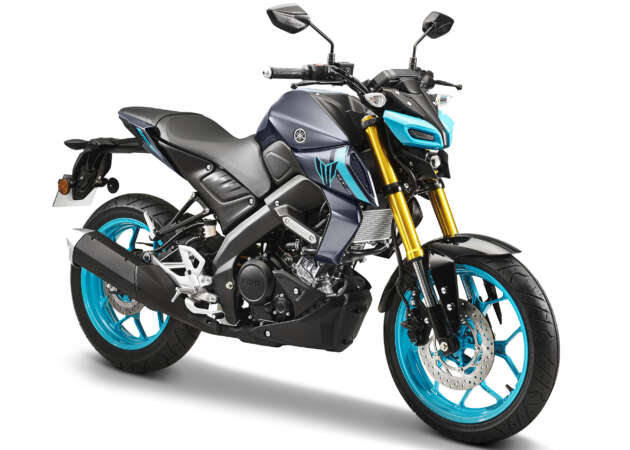
Following the colour update for the MT-25, the 2024 Yamaha MT-15 gets a new paint scheme choice in Malaysia, with pricing set at RM12,498, up RM200 from the 2022/2023 price. The new colour option for the MT-15 for this year is Midnight Cyan while Midnight Black is carried over.
Stocks of the updated MT-15 are expected in authorised Hong Leong Yamaha dealer showrooms immediately. Every MT-15 purchased comes with a two-year or 20,000 km warranty against manufacturing defects and a free disc lock worth RM100.
Otherwise, no changes for the MT-15 with power coming from a 155 cc, variable valve actuation, liquid-cooled, SOHC single-cylinder producing 19 hp at 10,000 rpm and 14.7 Nm of torque at 8,500 rpm. A six-speed, slipper and assist clutch equipped gearbox and chain final drive rotates the rear wheel.
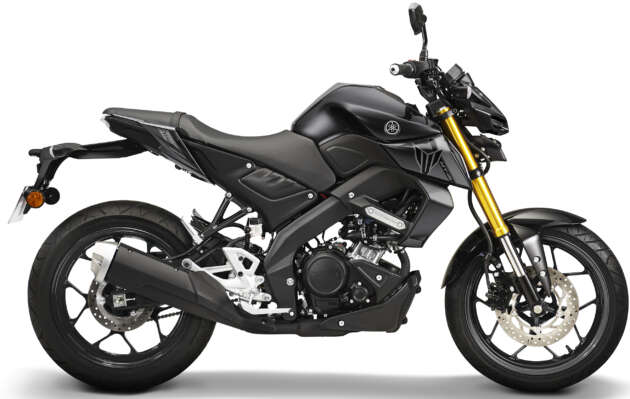
Suspension uses upside-down forks with gold anodised fork legs at the front end with a preload-adjustable monoshock at the back. Braking for the MT-15 is done with a single hydraulic disc on the front and rear wheels, with 17-inch wheels, shod with 110/7-0 front and 140/70 rear tyres.
10.4-litres of fuel is carried in the tank and weight for the MT-15 is claimed to be 133 kg, with seat height set at 810 mm. A monochrome LCD instrument panel displays all the necessary information with LED lighting used for the head and tail lights.
In Cars, Local News, Nissan / By Danny Tan / / 7 comments
There’s a fresh Nissan 3S centre in Cyberjaya. Operated by Evo Mobility, the RM1.5 million facility has been operating since January, ‘filling a crucial gap in the market’ as it caters to potential new customers in Cyberjaya, Sepang and Putrajaya areas.
Edaran Tan Chong Motor (ETCM) says that Evo Mobility carries over two decades of “strong and robust business acumen background in fuel distribution across the southern region,” and the company is now venturing into the automotive space.
Located at Jalan Autoville 2, Autoville Cyberjaya (the designated hub for automotive sales and repair businesses in the township), the 7,300 sq.ft. facility has space for up to five vehicles in the showroom, a dedicated new vehicle delivery area, customer lounge and two service bays. The latter is capable of servicing up to 200 vehicles per month.
Also, this new Cyberjaya outlet carries the latest Nissan Retail Concept (NRC), following the lead of Nissan’s flagship 3S centre in Petaling Jaya and three other outlets.
“The NRC was mooted to innovate Nissan dealerships and deliver world-class service standards to Nissan customers across the globe. It is centred on showcasing Nissan’s brand values across the entire customers’ journey at the dealership touchpoint, whether it is to test drive the latest model or to drop the car off for a regular service,” ETCM said, adding that more showrooms will undergo the NRC transformation.
The Nissan 3S in Cyberjaya is open seven days a week, from 9am till 7pm, for the showroom portion (03-76142215/019-2917100). The service centre (03-76142215) operates from 8am to 5pm on weekdays, and 8am to 1pm on Saturdays.
In Cars, International News, Toyota / By Gerard Lye / / 5 comments
Toyota today reported a net income of 4.9 trillion yen for the financial year 2024 (FY2024) ended March 31, 2024, which is 101.7% higher than what it managed in the previous financial year (FY2023).
The increase in net income was brought on by heightened demand for Toyota and Lexus vehicles, with over 10.3 million units sold globally in FY2024, or 7.3% more than in FY2023. The automaker saw strong demand in North America (+17%), Europe (+15.7%) and Asia (+3%).
Meanwhile, markets in the ‘Other’ category such as Central and South America, Oceania, Africa, the Middle East and others saw a sales increase of 4.6%. On the flipside, Toyota’s home market of Japan registered a sales decline of 3.7% due to the suspension of shipments caused by the Daihatsu safety scandal.
In terms of the types of vehicles sold, Toyota was keen to point out that sales of its electrified models went up by 35.3% to hit 3.855 million units in FY2024 compared to 2.849 million units in FY2023. Hybrids (HEVs) made up the bulk of electrified vehicle sales with 3.594 million units, a 32.1% increase from FY2023, while plug-in hybrids (PHEVs) saw a 60.3% jump to 141,000 units.
Sales of the automaker’s battery electric vehicles (BEVs) recorded the highest increase at 310.1%, although the total number of units is still less than PHEVs at 117,000 units. As for fuel cell electric vehicles (FCEVs), Toyota sold just 4,000 units in FY2024, which is 11.3% more than in FY2023.
With higher sales in FY2024 than in FY2023, the company’s sales revenue rose by 21.4% to 45 trillion yen, while operating income went up 96.4% to nearly 5.4 trillion yen. For the FY2025 ending March 31, 2025, the company is forecasting a modest increase in sales revenue to 46 trillion yen and a lower operating income of 4.3 trillion yen, the latter taking into account a total of two trillion yen in investments for the future, including expanding its multi-pathway strategy.
Toyota also forecasted sales of Toyota and Lexus models to hit 10.4 million units in FY2025, which is just 0.9% more than what was recorded for FY2024. Electrified models are expected to see a sales growth of 25.2% to 4.8 million units, with HEVs in particular expected to register an increase of 25.2% to nearly 4.5 million units.
In Local News / By Danny Tan / / 2 comments
Jalan Sultan Ismail has been fully reopened to traffic today, according to Jabatan Penerangan WPKL, quoting KLCCC DBKL. This follows yesterday’s fallen tree incident near Concorde Hotel that caused one death, one serious injury and damage to multiple cars.
The stretch, which is a busy section of a major artery in the city centre, has been cleaned up. However, the Monorail track, which was also in the path of the fallen tree, still needs work.
Rapid KL says that currently, cleaning up and rehabilitation work are being done with the assistance of DBKL. The operations team and structural engineers are making detailed checks to ensure that full operations can resume according to the set safety standards.
In the meantime, four stations will be closed to the public due to the need to shut off power to the track. The stations are Bukit Nanas, Raja Chulan, Bukit Bintang and Imbi. To support this disruption, 10 feeder buses will ply the route of the closed stations. The buses are free and will run on a frequency of 30 minutes, depending on traffic conditions. More on the Monorail’s disrupted service here.
In Local News / By Anthony Lim / / 0 comment
In March, Singapore announced that travellers arriving and departing Singapore by car via Woodlands and Tuas checkpoints would be able to use QR codes instead of passports for faster and more convenient immigration clearance.
Now, Malaysia is aiming to do the same, kicking things off with a trial run of a QR code immigration clearance system in Johor, The Star reports. The pilot project is set to be carried out in June at both the Bangunan Sultan Iskandar (BSI) and Sultan Abu Bakar Complex (KSAB) customs, immigration and quarantine (CIQ) facilities.
“The initial plan is for the pilot project to be carried out starting from June. However, there is a possibility for this to happen at a later date. It depends on whether the infrastructure and system being developed for the QR code clearance are ready by then,” state immigration director Baharuddin Tahir told the news publication.
He said that the QR code clearance will only be utilised for factory buses travelling through BSI and KSAB during the trial run. “We will only be carrying out the pilot project on factory buses. If everything runs smoothly, it will then be expanded to include other modes of transportation,” he said.
Search
Latest Fuel Prices
| PETROL | |
|---|---|
| RON 95 | RM2.05 (0.00) |
| RON 97 | RM3.47 (0.00) |
| RON 100 | RM5.00 |
| VPR | RM6.20 |
| DIESEL | |
| EURO 5 B10 | RM2.15 (0.00) |
| EURO 5 B7 | RM2.35 (0.00) |
Tools
Find out if you can afford your dream car using our user friendly car loan calculator.
Latest JPJ formula - calculate how much your vehicle's road tax will cost.
Latest JPJ formula - calculate how much your EV's road tax will cost.
Calculate how much you will have to spend on your car insurance.
Find out how much a car is worth to buy, sell or for insurance renewal.
Sales & Promotions

7th May 2024
3rd May 2024
20th March 2024
19th March 2024
12th March 2024
Local Car Launches
Malaysian News
Feature Stories
Car Reviews







